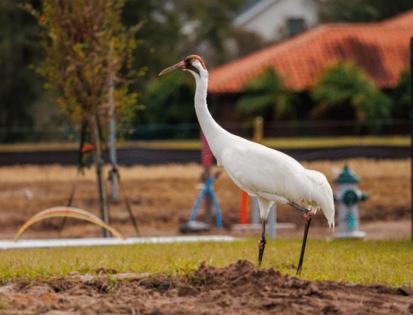Longtime Osceola whooping crane sent away, leaving only 4 in Florida
Published in Science & Technology News
ORLANDO, Fla. — Like so many others, the Northern transplant flew to Florida for warmer temperatures, landed in Osceola County and stayed over 20 years. Now he’s moved on.
This particular snowbird, however, was an actual bird — one of the last two whooping cranes in the region and one of just five in the state.
His departure leaves Central Florida without a local celebrity, at least among those in the know, while underscoring a failed, decades-long effort to establish a population of one of the world’s rarest birds in the Sunshine State.
“He’s a very handsome bird,” said Diane Gates, who traveled to see the crane after learning of him from posts on eBird, a website where bird-watchers post sightings. “It was kind of overwhelming because it’s so different and the guy is so huge.”
Only about 830 whooping cranes exist in the world but they used to number in the tens of thousands in North America alone, though they were not native to Florida.
The whooping crane was listed by the U.S. Fish and Wildlife Service as threatened in 1967 and endangered in 1970. The agency said the bird’s name probably originated from the loud, single-note vocalization it makes repeatedly when alarmed.
The 25-year-old Osceola bird, known as 1018 for the number on the metal band encircling his leg, had hatched in a Maryland facility. But he became a fixture of the Buena Lago neighborhood under construction just outside St. Cloud off the shore of Alligator Lake.
State wildlife officials relocated him to Louisiana earlier this month to live in a colony of dozens of his kind. He left behind his ex-wife, who is also his sister. She is shier and not often seen.
In contrast, 1018’s height of 5 feet and stark white feathers made him a star in the community. He caught the attention of bird-watchers near and far.
“I was just really amazed by his size,” said Ashley Hill, 23, a resident who’d seen the crane on walks with her dog, Zen. “I Googled him because I have never seen a bird like that — so he is really cool.”
Gates drove over an hour from her Merritt Island home to Osceola for a chance to see a whooping crane in real life for the first time in over 15 years of bird-watching.
“I watched him fly in with two sandhill cranes and he was making some sounds so he was pretty vocal,” she said. “I parked my Jeep and he like walked right next to my Jeep … looking for food.”
Those entering Buena Lago are greeted by rows of townhomes with dark blue doors and a clubhouse pool. Roughly 50 homes are occupied, mainly by families, but hundreds of lots sit empty with weeds and pipes for water connections rising up from the grass.
The Florida Fish and Wildlife Conservation Commission on March 6 captured 1018 from this subdivision and relocated him to Louisiana where a population of 73 cranes live. He was wandering Buena Lago alongside much-smaller sandhill cranes — mating with them and begging for food, a behavior researchers said was problematic.
Tim Dellinger, an avian researcher for FWC and part of the team which captured 1018, said with only two females left in the state it’s highly unlikely he’d find a mate. He said moving him was his best bet to find one — he can reproduce even after age 25, but not for much longer.
“We just didn’t feel like he would survive much longer [in Buena Lago] as they’ve already put in the roads for the new development,” Dellinger said. “They’re starting to build houses and so he may walk up and get hit by a car.”
Experts also grew concerned he’d lost the fear of human interaction just as his habitat was shrinking with the community planned for over 300 homes starting to rise up around him.
Larry Rosen, with Audubon of Osceola County, said every time a piece of land is developed it takes away habitat from many species of birds.
“Birds can’t breed on a driveway or parking lot,” Rosen said. “Development definitely has an impact — that’s one of our biggest problems with wildlife here in Osceola County.”
Some bird species adapt better to living in subdivisions, like meadowlarks or sandhill cranes, he said, but whooping cranes stand out due to their height — they are the tallest birds in North America. He said the fearless nature of 1018 around people was an indication they were feeding him, which is illegal.
“They’ve done very well coming into subdivisions and foraging on people’s lawns,” Rosen said. “But their natural habitat is out on the prairie and in wetlands so they get hit by cars a lot.”
Dellinger said 1018 was part of the state’s experimental effort to create a self-sustaining population of cranes — 289 were released into the wild between 1993 and 2005. The effort failed largely due to high mortality and low reproductive success.
“Their survival was difficult mainly because of predation from bobcats and then we had a number of birds hit by power lines and more areas are being developed so you’re kind of losing the marshes too,” he said.
After hatching in 2000, 1018 was brought to Florida and released alongside seven others in 2001 near headwaters to the Everglades. But he flew north to just outside the St. Cloud city limits — where he’d been since 2004.
The birds are generally monogamous but will “divorce” if they repeatedly fail to successfully raise chicks with their mates.
Dellinger said 1018’s first mate died in 2010 after an alligator bite.
“An alligator actually came up and took the leg off the female and we had a fake egg in the nest that was recording information and it chomped that too,” he said.
In December he “divorced” his second mate — the last remaining crane in Osceola. He’s had multiple chicks but only one survived — a daughter hatched in 2006 who now lives in the Gainesville area.
The Florida relocation effort officially ended in 2012 but Louisiana’s experimental self-sustaining population has been successful.
The Louisiana Department of Wildlife and Fisheries has reintroduced captive-reared whooping cranes to the White Lake Wetlands Conservation Area in the southwestern part of the state since 2011 and that’s 1018’s new home. The area of about 72,000 acres provides cranes ample space to roam.
But 1018 isn’t the only whooping crane to move from Florida to Louisiana. Since 2019, five have been relocated and three have found mates and nested.
Dellinger said 1018 will be released into the wild with other whooping cranes but needs to gain weight and get healthier first.
As far as the other two cranes in Florida, one hatched in 2000 is in the Lake Wales area and another hatched in 2003 lives in Sumter County.
-------------
©2025 Orlando Sentinel. Visit at orlandosentinel.com. Distributed by Tribune Content Agency, LLC.







Comments